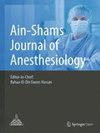Pre-emptive ultrasound-guided superior hypogastric plexus block in pelvic cancer surgeries: a randomized double-blinded study
IF 0.5
Q4 ANESTHESIOLOGY
引用次数: 0
Abstract
Abstract Background Superior hypogastric plexus is a retroperitoneal plexus that receives visceral sensation from pelvic viscera. Superior hypogastric plexus block (SHPB) was used for chronic pelvic pain and recently studied for postoperative pain. We examined the safety and efficacy of preemptive anterior US-guided SHPB to reduce postoperative morphine consumption. Thirty-six patients undergoing pelvic cancer surgery were randomly divided into two equal groups; group S in which patients received anterior US-guided SHPB immediately after induction of general anesthesia and before skin incision using 20 ml bubivacaine 0.5%, group C control group in which 20 ml normal saline was given by the same technique. Patients of both groups received morphine via PCA postoperative and followed for 24 h. In both groups, we measured the total morphine consumption, VAS, vital signs, and side effects. Results Demographic data, duration, and type of surgery were comparable in both groups. Total 24 h morphine consumption in mg was significantly lower in group S (43.8 ± 2) than in group C (54.83 ± 2) with P value < 0.001. VAS was significantly lower in group S in all time intervals from 2 till 24 h postoperative. Side effects were minimal with no significant difference between both groups. Conclusion Preemptive US-guided SHPB is a relatively safe and effective method to reduce postoperative opioid demands after pelvic cancer surgeries. Trial registration ClinicalTrials.gov NCT04732234 in 1–2-2021.超声引导下胃上丛阻滞在盆腔癌手术中的应用:一项随机双盲研究
背景:腹下上神经丛是腹膜后神经丛,接受盆腔脏器的内脏感觉。胃下上神经丛阻滞(SHPB)用于治疗慢性盆腔疼痛,最近研究了术后疼痛。我们检查了先发制人的前路us引导SHPB减少术后吗啡消耗的安全性和有效性。36例盆腔癌手术患者随机分为两组;S组全麻诱导后即刻切开皮肤前用0.5%布比卡因20 ml行前路us引导SHPB; C组对照组按相同方法给予生理盐水20 ml。两组患者术后均经PCA给予吗啡,随访24 h。我们测量两组患者吗啡总消耗量、VAS、生命体征及不良反应。结果两组的人口学数据、持续时间和手术类型具有可比性。S组24 h吗啡总消耗量(mg)(43.8±2)显著低于C组(54.83±2)(P值<);0.001. 术后2 ~ 24 h, S组VAS均明显降低。副作用极小,两组间无显著差异。结论先发制人的us引导SHPB是减少盆腔癌术后阿片类药物需求的相对安全有效的方法。临床试验注册:ClinicalTrials.gov NCT04732234,注册日期:1-2-2021。
本文章由计算机程序翻译,如有差异,请以英文原文为准。
求助全文
约1分钟内获得全文
求助全文

 求助内容:
求助内容: 应助结果提醒方式:
应助结果提醒方式:


